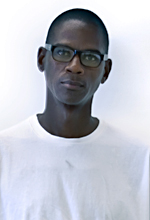My assignment for you is in three different parts and will hopefully help you to see more clearly how you feel and relate to the immediate world you live in.
Assignment #1
Song Text Piece: Arrangement/Subtraction
Pick a song with lyrics that you like, then type the lyrics into the computer. Pick a font you like and make the type size 36 or 48, so that it’s big enough to read at a distance, and then print the whole thing out. Cut the words out and arrange them on a large poster-sized sheet of paper. Finally, use scissors and cut out words that you don’t like, or that make you feel bad or uncomfortable.
… if you re-arrange the words out of order, is it a remix?
Assignment #2
Mapping the Lunchroom: Visual Information as Abstraction
Using a large poster-sized piece of paper (24 x 36 inches, for example), draw a map of the lunch room or cafeteria in your school. Consider the architecture (tables, chairs, walls, cashier, etc.). On a second piece of paper laid on top of the map, draw the social groups that form within the space. Also draw how people move through the space. Think about how to articulate the information using color, shape, and line-red dots for the cheerleaders, blue squares for the basketball players, yellow lines for how the hipsters enter and exit the room.
Is abstraction inherently all around us, and is expressing it simply a matter of separating it from the architecture of everyday life?
Assignment #3
Blind Sculptures: Displacing Linear Process, Physical Translation
This assignment is done in two parts: a contour drawing of a self-portrait, then a sculptural translation of the portrait.
With eyes closed, draw your own head (from the shoulders up). Use your non-drawing hand to feel your features from the back of your neck, up and over the skull, across the hairline, down the forehead, and around the eye sockets, nose, cheeks, lips, and chin. Translating touch into drawing usually works best when the pencil never leaves the paper—create this portrait with one long, single line.
Next, translate your contour drawings into three dimensions. Using paper and masking tape, students should use their drawings as guides (paper and tape is cheapest, but you can use anything, really: wire, clay, etc.).
The larger idea is that the choices you make might reveal who you are as a young adult and how you translate your identity into art work.
Everything that you’ll ever need to make art is already all around you. How can these ideas be adapted to something more specific to where and how you live and study?
Remember that these are only suggestions, places to start. If you start to wander, just go with it and see where you end up.
And, of course, have a great time!
Artist Biography
 Photo (detail) by Frederik Nilsen
Photo (detail) by Frederik NilsenCurrently lives in Los Angeles, California
As a young boy, Mark Bradford created signs for his mother’s Los Angeles beauty shop. At the time, he did not have aspirations of becoming an artist. Yet the process of making things—and an acute awareness of signage—provided the foundation for a long and successful career as an artist, for which he was named a MacArthur “genius” Fellow in 2009.
Bradford’s art takes the form of installations, video, public art, and collage, and often incorporates found objects, such as signage from his neighborhood, into massive, mixed-media abstractions laden with texture. His mixed-media work is born out of a time-intensive process of painting and sanding, layering materials, and then chipping them away. He takes his inspiration from the stuff of everyday life that surrounds him in South Los Angeles. But he is as much inspired by modernist abstract art and issues of immigration, race, and civil rights as he is by signs, basketball, parades, and maps. Learn more about Bradford’s work in an online presentation on the Wexner Center for the Arts’ Web site. The site accompanies the first major survey of Bradford’s work, on view at the Wexner Center in Columbus, Ohio through October 10, 2010.
 Mithra, Mark Bradford, 2008. Mixed media, 80 x 40 x 20 ft. Photo courtesy of the artist.
Mithra, Mark Bradford, 2008. Mixed media, 80 x 40 x 20 ft. Photo courtesy of the artist.
 Monumento, Mark Bradford, 2008. Mixed media, 4 x 5 ft. Photo courtesy of Sikkema Jenkins & co., New York, NY.
Monumento, Mark Bradford, 2008. Mixed media, 4 x 5 ft. Photo courtesy of Sikkema Jenkins & co., New York, NY.
